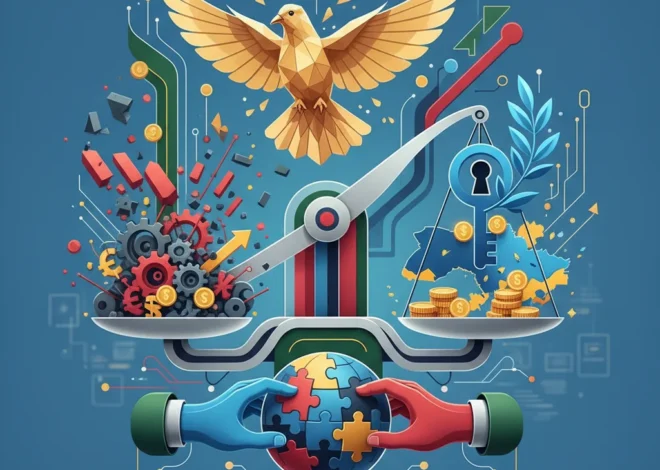
The Nvidia Paradox: Why a Booming AI Giant Can’t Calm a Nervous Stock Market
In the world of finance and investing, a blowout earnings report from a market bellwether is typically a cause for celebration. When that bellwether is Nvidia, the undisputed king of the AI revolution, expectations soar. The company recently posted yet another quarter of staggering growth, shattering analyst predictions and cementing its role as the primary engine of technological advancement. And yet, the morning after, a strange and unsettling silence fell over the markets. Instead of a euphoric rally, both US and Asian indices saw a sea of red. The stock market, it seems, is suffering from a case of cognitive dissonance.
Strong sales from the artificial intelligence chip giant did little to quell investor worries, with major indexes in the US and Asia sliding in subsequent trading sessions. This perplexing reaction begs a critical question: If the AI gold rush, personified by Nvidia’s triumph, isn’t enough to propel the market forward, what invisible anchors are holding it back? This isn’t just a story about one company; it’s a revealing look into the deep-seated anxieties shaping the global economy, the intricate dance between technological hype and macroeconomic reality, and the challenges facing every investor today.
The Unstoppable Force: Decoding Nvidia’s Dominance
To understand the market’s strange reaction, we must first appreciate the sheer scale of Nvidia’s success. The company isn’t just a participant in the AI boom; it is the primary architect. Its advanced GPUs (Graphics Processing Units) are the foundational “picks and shovels” for nearly every major AI model, from ChatGPT to Midjourney. This has created a demand so voracious that it has propelled the company into the stratosphere.
In its most recent fiscal report, Nvidia announced quarterly revenue that had more than tripled from the previous year, a figure that would be astonishing for a startup, let alone a multi-trillion-dollar behemoth. According to a report from Reuters, the company’s data center revenue, which includes its flagship AI chips, surged by a staggering 427% year-over-year, reaching $18.4 billion. This isn’t just growth; it’s a paradigm shift, a testament to the transformative power of a new technological era. In a rational market, such news should have been a powerful tailwind, lifting not just the tech sector but the entire market on a wave of optimism.
But the market is not always rational. It is a complex ecosystem of fear, greed, and, most importantly, competing narratives. While the AI narrative is powerful, it is currently clashing with a much older and more formidable story: the battle against inflation and the uncertain future of the global economics landscape.
Ghosts of Economic Past: Why a 1970s Socialist Blueprint Still Haunts Modern Finance
The Immovable Object: The Macroeconomic Headwinds
The market’s jitters can be traced to a potent cocktail of macroeconomic concerns that even Nvidia’s stellar performance cannot mask. These are the fundamental issues that affect every corner of the market, from multinational corporations to small businesses and individual investors.
1. The Persistent Shadow of Inflation
The primary antagonist in the current market drama is inflation. Despite efforts by central banks worldwide, price pressures remain stubbornly high in key sectors. Recent data shows that while headline inflation has cooled, core inflation (which excludes volatile food and energy prices) remains a significant concern. This persistence has forced central banks, particularly the U.S. Federal Reserve, to maintain a hawkish stance. The minutes from the Fed’s recent meetings revealed a committee in no rush to cut interest rates, with officials expressing concern that “the recent disinflationary trend might not be sustainable.” This sentiment was clearly articulated in their latest meeting summary, where they emphasized the need to see more “good data” before considering a policy pivot, as noted by the Federal Reserve itself.
2. “Higher for Longer” Interest Rates
The direct consequence of sticky inflation is the “higher for longer” interest rate environment. When rates are high, the cost of borrowing increases for both companies and consumers, slowing down economic activity. For the stock market, this has two major negative effects. First, it makes safer investments like government bonds more attractive. Why risk your capital in volatile equities when you can get a respectable, guaranteed return from a T-bill? Second, higher rates compress the valuation of growth stocks. The future earnings of companies like Nvidia are worth less in today’s dollars when discounted at a higher rate, putting downward pressure on their stock prices despite strong operational performance.
3. A Worryingly Narrow Market
Another major red flag for seasoned investors is the market’s lack of breadth. The rally over the past year has been famously narrow, driven largely by a small handful of mega-cap technology stocks known as the “Magnificent Seven.” While these companies have posted incredible gains, the average stock has languished. This indicates that the market’s foundation is weak. A healthy bull market is like a rising tide that lifts all boats; a narrow market is more like a single, spectacular geyser. It’s impressive, but it doesn’t signify a healthy, underlying water table. This concentration of gains in a few names makes the entire market vulnerable to a downturn if these few leaders falter.
Below is a summary of the key factors currently weighing on investor sentiment, creating a tug-of-war between technological optimism and economic caution.
| Factor | Implication for the Stock Market |
|---|---|
| Persistent Inflation | Erodes corporate profit margins and consumer purchasing power, leading to lower earnings expectations. |
| Hawkish Central Banks | Signals a “higher for longer” interest rate policy, which increases borrowing costs and dampens economic growth. |
| Narrow Market Breadth | Indicates a fragile rally dependent on a few mega-cap stocks, increasing systemic risk. |
| Geopolitical Instability | Creates uncertainty, disrupts supply chains, and can lead to volatility in energy and commodity prices. |
| Slowing Global Growth | Concerns about economic slowdowns, particularly in key regions like Asia and Europe, impact global demand. |
The Fintech Factor: How Modern Trading Amplifies Volatility
The infrastructure of modern trading itself plays a role in this dynamic. The rise of fintech and sophisticated financial technology has democratized market access but has also increased the speed and potential for volatility. High-frequency trading (HFT) algorithms can react to news like the Fed minutes in microseconds, selling off broad baskets of stocks based on keyword analysis before a human investor has even finished reading the headline. This can exacerbate downward moves and create a sense of panic that may not be fully justified by the underlying data.
Furthermore, while the proliferation of retail investing apps is a positive for financial inclusion, it can also contribute to herd-like behavior. When market sentiment shifts, as it has from unbridled AI optimism to macroeconomic caution, millions of investors can move in the same direction at once, amplifying price swings. The role of banking institutions and their research desks also contributes, as a single influential downgrade or cautious report can trigger a cascade of automated and retail selling.
The European Paradox: Why Stronger Nations Might Build a Stronger Union
A Playbook for the Prudent Investor
So, how should an investor navigate this paradoxical environment? While the future is always uncertain, a few timeless principles of investing can provide a steady hand.
- Diversify Beyond the Hype: The current market is a stark reminder of the dangers of concentration. While it’s tempting to put all your chips on the AI darlings, a well-diversified portfolio across different sectors, geographies, and asset classes is the most reliable defense against sector-specific downturns or macroeconomic shocks.
- Focus on Quality and Fundamentals: Look beyond the narratives to the numbers. Companies with strong balance sheets, consistent cash flow, and reasonable valuations are better equipped to weather economic storms than those running on pure speculation. The era of “growth at any cost” is being replaced by a renewed focus on profitability.
- Maintain a Long-Term Horizon: Don’t let short-term volatility derail a long-term strategy. The market’s daily gyrations are often noise. The real signal is the long-term trajectory of the global economy and technological innovation. The AI revolution will continue to unfold over years and decades, creating opportunities for patient investors who can look past the immediate anxieties.
The Paradox of India's Growth: Why a Booming Economy is Begging for a Spending Spree
Conclusion: A Market at a Crossroads
The curious case of Nvidia and the nervous market serves as a powerful lesson in modern finance. It demonstrates that no single company, no matter how innovative or profitable, is an island. The stock market is an interconnected ecosystem where technological optimism is constantly being tested by the harsh realities of interest rates, inflation, and global economic health.
Nvidia’s success is a genuine and exciting development, heralding a new wave of productivity and innovation. However, the market’s hesitant reaction is a prudent and necessary check on that enthusiasm. It’s a reminder that the fundamentals of economics still matter. Investors are now tasked with the difficult job of balancing the incredible long-term promise of technologies like AI with the very real short-term risks in the global economy. The path forward will likely remain volatile, but for those who understand the forces at play, it will also be ripe with opportunity.


